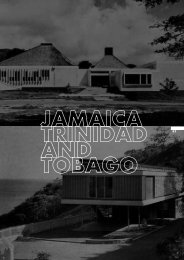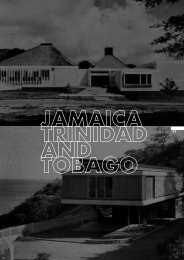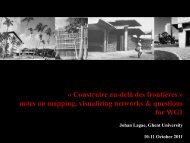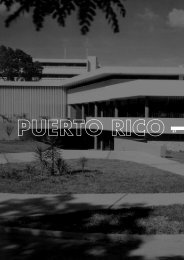82 | ARTIGOSefectuado nesse ano na capital, uma vez que haviauma grande falta de meios e que todos os esforçosestavam centrados na construção de estradas, muitoimportantes para a viabilidade do caminho-deferro.that there was an apparent lack of resources and allefforts had been concentrated on the constructionof roads, which were very important for the feasibilityof the railway.CONSOLIDAÇÃO E EXPANSÃODO ESPAÇO URBANO (1882-1926)A PRIMEIRA EXPANSÃO DA CIDADE:O ALTINHODatam de 1879 as primeiras referências conhecidasao Altinho, quando Caetano Albuquerque mencionoua conveniência de ir atraindo os habitantesde Pangim para o “Bairro Alto”, como lhe chama,numa clara referência a Lisboa. As boas condiçõesde salubridade e a possibilidade de aqui alojar osexpropriados que resultavam das obras de melhoramentoque estavam a ser efectuadas na zona baixada cidade, eram os principais motivos que apontavapara esta ocupação. Referiu-se ainda que, umavez que o bairro iria ser começado a construir deraiz, se deveriam estabelecer regras de construçãoe defi nir um desenho: “dividindo-o em quarteirões(…) dando ás novas ruas a largura conviniente euma casa modesta, mas confortável, destinada auma familia não abastada - que deveria ali construir-sepor conta do Estado, a fi m de poder servirde modelo para novas construções.” 60 Entre 1882 e1885, o Outeiro e o bairro das Fontainhas, foramligados através de uma escadaria 61 que terminavana Rua de Natal 62 , começando assim a fazer-se osacessos do novo bairro ao resto da cidade.O bairro só foi inaugurado em 1886. Era entãoconhecido como Alto de Guimarães 63 e a fi losofi ada sua ocupação tinha entretanto sofrido transformações.O governador Ferreira do Amaral (1886)referia que o bairro “(…) constituirá no alto doouteiro um bairro elegante, que será o MalabarHill, de Bombaim, onde os abastados negociantestêem os mais bonitos e elegantes challetes, ou bungalows.”64 A mudança de estratégia de ocupaçãodo bairro era clara, assim como a alteração dasreferências: Bombaim substituía Lisboa.Na transição do século XIX para XX, a infl uênciaportuguesa perdeu importância e foi o modelourbano e social da Índia inglesa, importado deBombaim, que persistiu na urbanização do Altinho aCONSOLIDATION <strong>AND</strong> EXPANSIONOF <strong>THE</strong> URBAN SPACES (1882-1926)<strong>THE</strong> FIRST EXPANSION OF <strong>THE</strong> CITY:ALTINHOThe fi rst known references to Altinho date from1879, when Caetano Albuquerque referred to theconvenience of attracting residents from Panjim tothe Bairro Alto (high-lying neighbourhood), as hecalled it, in a clear reference to the district of thesame name in Lisbon. The good health conditionsand the possibility of housing those expropriated asa result of the redevelopment works in the lowerparts of the city were the main reasons for theoccupation of this area. It was also pointed out that,given that the neighbourhood was going to be builtfrom scratch, certain construction regulations wereto be established and a plan be devised: “dividing itinto blocks (…) giving the new streets a convenientwidth and modest but comfortable houses designedfor families that are not wealthy – which should bebuilt at the expense of the State so as to serve as amodel for new constructions” 60 . From 1882 to 1885the Outeiro and the Fontainhas neighbourhoodwere connected by a stair 61 which ended up at Ruade Natal 62 , the fi rst connection between the newneighbourhood and the rest of the city.The neighbourhood was inaugurated only in 1886under the name of Alto de Guimarães 63 . The philosophybehind its occupation had since undergonesome changes. The Governor Ferreira do Amaral(1886) stated that it “(…) will constitute, on theOuteiro heights, an elegant neighbourhood, similarto Malabar Hill in Bombay, where the wealthy merchantshave the most pleasant and elegant chaletsor bungalows” 64 . The change in strategy as well asin infl uences was clear: the reference was no longerLisbon, but had become Bombay.At the turn of the century, the Portuguese culturelost infl uence in Goa and it was the urban and socialmodel of British India, imported from Bombay, thatprevailed in the urbanisation of Altinho from theearly 20 th century onwards. With Malabar Hill as aMURPHY 2 | Julho 2007Pangim entre o Passado e a Modernidade
ARTICLES | 83{Fig 12}partir do início do século XX. À imagem de MalabarHill, o Altinho cresceu com a construção de casaspara a elite abastada de Goa e para funcionáriosportugueses que vinham da metrópole.Ferreira do Amaral defendia também a construçãode um edifício-modelo para o novo bairro: o“bungalow do governo”, que acabou por nunca serconstruído. Pelo contrário, o maior e mais importanteedifício do Altinho foi obra da Igreja católica:o Palácio do Arcebispo, que acabou por marcar obairro na transição para o novo século. Ficou assimà vista a importância da tradição católica goesa, dasinstituições eclesiásticas, e a fragilidade do governolocal e das instituições, aquilo que hoje designaríamoscomo “sociedade civil”.Em 1903 continuam a fazer-se obras de aberturade arruamentos 65 relacionadas com a construçãodo Paço (que estava inicialmente previsto para azona a norte das Fontainhas 66 ). Foi porém maistarde, na década de 1920, que se iniciou a consolidaçãodo Altinho (Fig. 12). O novo impulso foidado mais uma vez por um edifício ligado à Igreja- o Recolhimento da Serra, instituição tutelada pelaMisericórdia - e que se transformaria depois noLiceu Afonso de Albuquerque. 67“Nova estrada de acesso ao alto do Patriarca,em Pangim, recentemente conclu’ da. Troço Inferiorligado a Rua de Calicut”, 1923-1926.[AHU, n.º ordem 2179, Relatório da Direcçãodas Obras Públicas do Estado da ê ndia doano económico de 1924-25 pelo EngenheiroDirector Affonso Zuzuarte de Mendonça]“New access road to the alto do Patriarcain Panjim, recently fi nished. Lower sectionconnected with Rua de Calicut”, 1923-1926.[AHU, no. 2179, Repport of the Direcçãodas Obras Públicas do Estado da ê ndia economicalyear of 1924-25 signed by the engineerand director Affonso Zuzuarte de Mendonça]reference, Altinho grew with the building of housesfor the wealthy elite of Goa and for Portuguese civilservants from Europe.Mousinho d’Albuquerque also favoured theconstruction of a model bulding – the governmentbungalow – for the new neighbourhood but itnever became a reality. On the contrary, the largestand most important building in Altinho was anecclesiastic building, the Archbishop’s palace, whichended up characterising the neighbourhood at theturn of the century. The importance of the Catholictradition in Goa and of the ecclesiatic institutionswas thus clearly shown, as was the weakness of thelocal government and the institutions of what todaywe would call “civil society”.In 1903 streetbuilding works 65 related with the constructionof the palace were still being carried out (thepalace was originally planned for the area to thenorth of Fontainhas 66 ). It was, however, not untillater, in the 1920s, that the consolidation of Altinhobegan (Fig. 12). The new impulse was given oncemore by a church building – the Recolhimento daSerra, an institution run by the Misericórdia charityorganisation – that was later to become Afonso deAlbuquerque grammar school 67 .Panjim between the past and modernityJuly 2007 | MURPHY 2












